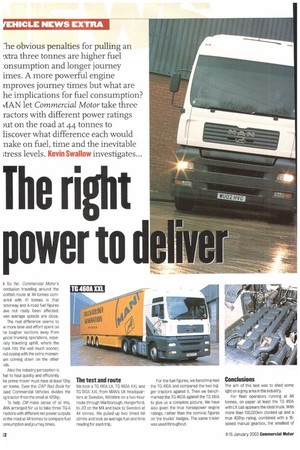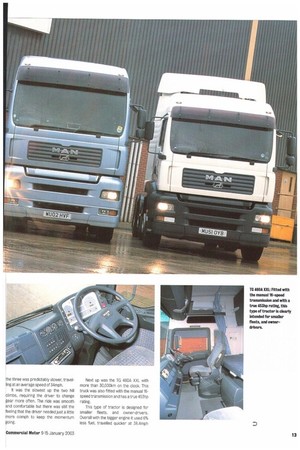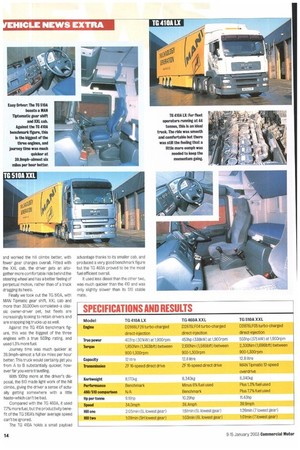The right power to d
Page 12

Page 13

Page 14

If you've noticed an error in this article please click here to report it so we can fix it.
I So far, Commercial Motor's onclusion travelling around the ;cottish route at 44 tonnes cornared with 41 tonnes is that lotorNay and A-road fuel figures ave not really been affected; ven average speeds are close.
The real difference seems to e more time and effort spent on he tougher sections away from vpoal trunking operations, espe ially uphill, where the ruck hits the wall much sooner, ,nd coping with the extra momenum coming down on the other Also the industry perception is hat to haul quickly and efficiently he prime mover must have at least 10hp er tonne. Even the CAP Red Book for Jsed Commercial Vehicles divides the iig tractor from the small at 420hp.
To help CM make sense of all this, AAN arranged for us to take three TG-A ractors with different net power outputs w the road at 44 tonnes to compare fuel ...onsumption and journey times.
The test and route
We took a TG 4104 LX, TG 460A XXL and TG 510A XXL from MAN's UK headquarters at Swindon, Wiltshire on a two-hour route through Marlborough, Hungerford, to J13 on the M4 and back to Swindon at 44 tonnes. We pulled up two timed hill climbs and took an average fuel and time reading for each trip.
For the fuel figures, we benchmarked the TG 4104 and compared the two bigger tractors against it. Then we benchmarked the TG 4604 against the TG 5104 to give us a complete picture, We have also given the true horsepower engine ratings, rather than the nominal figures on the trucks' badges. The same trailer was used throughout. Conclusions The aim of this test was to shed some lighten a grey area in the industry.
For fleet operators running at 44 tonnes, on paper at least the TG 410A with LX cab appears the ideal truck. With more than 100,000km clocked up and a true 403hp rating, combined with a 16speed manual gearbox, the smallest of the three was predictably slower, travelling at an average speed of 34mph.
It was the slowest up the two hill climbs, requiring the driver to change gear more often. The ride was smooth and comfortable but there was still the feeling that the driver needed just a little more oomph to keep the momentum going. Next up was the TO 460A XXL with more than 30,000km on the clock. This truck was also fitted with the manual 16speed transmission and has a true 453hp rating.
This type of tractor is designed for smaller fleets, and owner-drivers. Overall with the bigger engine it used 6% less fuel, travelled quicker at 38.4mph and worked the hill climbs better, with fewer gear charges overall. Fitted with the XXL cab, the driver gets an altogether more comfortable ride behind the steering wheel and has a better feeling of perpetual motion, rather than of a truck dragging its heels.
Finally we took out the TG 510A, with MAN Tipmatic gear shift, XXL cab and more than 30,000km completed—a classic owner-driver pet, but fleets are increasingly looking to retain drivers and are snapping big trucks up as well.
Against the TG 410A benchmark figure, this was the biggest of the three engines with a true 503hp rating, and used 1.3% more fuel.
Journey time was much quicker at 39.9mph—almost a full six miles per hour better. This truck would certainly get you from A to B substantially quicker, however far you were travelling.
With 100hp more at the driver's disposal, the 510 made light work of the hill climbs, giving the driver a sense of actually getting somewhere with a little haste—which can't be bad. advantage thanks to its smaller cab, and produced a very good benchmark figure but the TO 4604 proved to be the most fuel efficient overall.
It used less diesel than the other two, was much quicker than the 410 and was only slightly slower than its 510 stable mate.
























































































































































